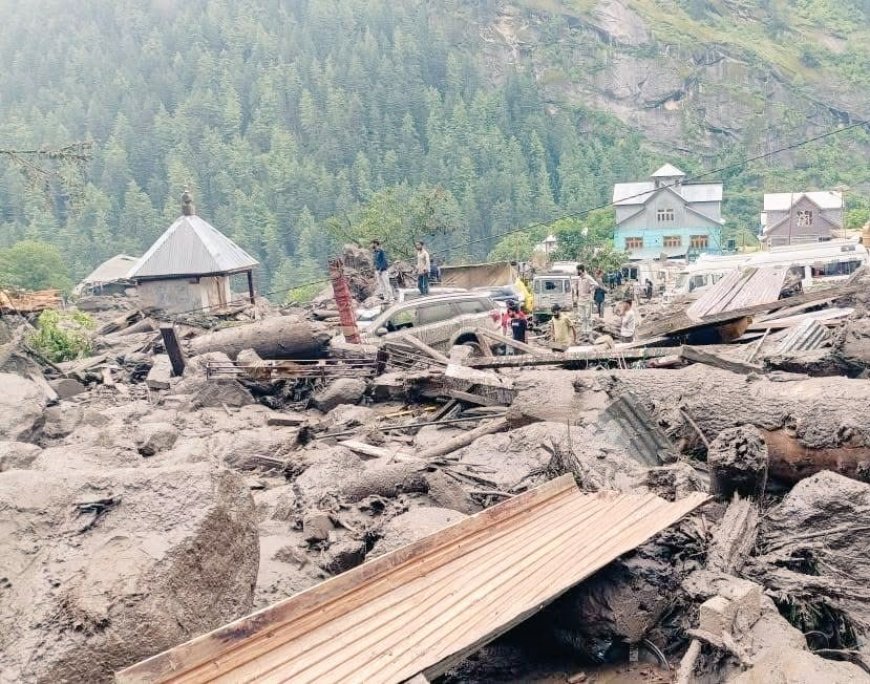Cloudburst in Kishtwar: Lives Lost, Homes Swept Away
Kishtwar hit by a sudden cloudburst, causing deaths, destruction, and displacement. Rescue teams race against time amid blocked roads and heavy rains.

Introduction
Kishtwar, a picturesque district in Jammu & Kashmir known for its serene valleys and rivers, was struck by a tragic cloudburst, leaving behind destruction and grief. Cloudbursts are sudden and intense rainfall events that release massive amounts of water within minutes, often triggering flash floods and landslides. This incident has not only shocked the locals but also drawn national attention due to its severity.
Brief History of Cloudbursts in the Region
Jammu & Kashmir, especially districts like Kishtwar, has experienced multiple cloudburst incidents over the years due to its mountainous terrain and unpredictable weather patterns. Past events in Ladakh, Poonch, and Kargil have shown the vulnerability of these areas, but the Kishtwar disaster stands out for its suddenness and scale of devastation.
What Happened in Kishtwar
In the early hours, without warning, heavy rains turned into an intense cloudburst over remote villages in Kishtwar. Within minutes, gushing water and debris swept through houses, roads, and farmlands. Reports indicate that multiple houses were washed away, roads were blocked, and agricultural land was destroyed. Rescue teams rushed to the site, but access was severely hampered by damaged routes and ongoing rainfall.
Casualties and Impact
Preliminary figures suggest several fatalities, with many more missing. Dozens of people have sustained injuries, and livestock losses are significant. Entire families have been displaced, forced to take shelter in temporary camps set up by the administration. The destruction of infrastructure such as bridges, power lines, and drinking water facilities has further worsened the crisis.
Possible Reasons Behind the Cloudburst
Meteorologists point to a combination of factors:
-
Geography: Kishtwar’s location in a hilly terrain makes it prone to sudden weather changes.
-
Climate Change: Global warming has intensified unpredictable rainfall patterns.
-
Deforestation: Reduced vegetation increases runoff during heavy rains.
-
Poor Drainage Systems: Limited infrastructure to channel rainwater leads to flash flooding.
Current Situation on Ground
Rescue and relief operations are ongoing, with NDRF, SDRF, and local volunteers working around the clock. Food, water, and medical aid are being distributed. Authorities are also setting up emergency shelters for displaced families. The government has promised immediate financial assistance to the affected households.
Importance and Significance of the Incident
This tragedy highlights the urgent need for:
-
Better weather forecasting systems in hilly regions.
-
Climate resilience infrastructure.
-
Community awareness about disaster preparedness.
-
Sustainable land-use practices to prevent large-scale runoff.
Advantages & Disadvantages of Relief Efforts
-
Advantages: Quick mobilization of rescue forces, rapid setting up of relief camps, and national attention ensuring faster aid.
-
Disadvantages: Accessibility challenges due to damaged roads, slow aid distribution in remote areas, and limited medical facilities.
Final Thoughts & Conclusion
The Kishtwar cloudburst is a sobering reminder of nature’s unpredictability and the pressing challenges posed by climate change. While immediate relief is crucial, long-term measures—such as afforestation, robust infrastructure, and accurate early warning systems—are equally essential. This disaster must be a wake-up call to strengthen preparedness and protect vulnerable communities in high-risk zones.

 Ellofacts
Ellofacts 





